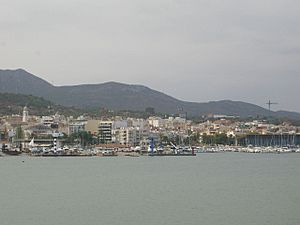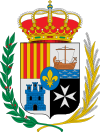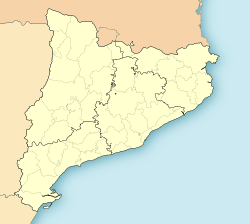La Ràpita facts for kids
Quick facts for kids
La Ràpita
|
|||
|---|---|---|---|
|
Municipality
|
|||
 |
|||
|
|||
| Country | |||
| Community | |||
| Province | Tarragona | ||
| Comarca | Montsià | ||
| Area | |||
| • Total | 53.7 km2 (20.7 sq mi) | ||
| Elevation | 11 m (36 ft) | ||
| Population
(2018)
|
|||
| • Total | 14,611 | ||
| • Density | 272.09/km2 (704.7/sq mi) | ||
| Demonym(s) | Rapitenc, rapitenca | ||
La Ràpita (Western Catalan: [la ˈrapita]) is a charming town located in the Montsià area of Catalonia, Spain. It sits on the coast, close to where the Port dels Alfacs lagoon meets the sea. This town is a great place to visit, known for its beautiful scenery and lively atmosphere.
Contents
Discover La Ràpita: A Coastal Town in Spain
La Ràpita is found in the southwest part of the Ebro Delta. This area includes unique natural features like the el Trabucador isthmus and the la Banya peninsula. These landforms help create the large, calm saltwater lagoon called the Port dels Alfacs.
A Glimpse into La Ràpita's Past
The town of La Ràpita was started by Charles III of Spain. He wanted to build a major port here to help with trade to Spain's colonies around the world. The town was designed in a grand, classical style. However, after Charles III passed away, much of the construction was never finished.
What Makes La Ràpita Special?
La Ràpita is famous for a few important things. It's a big producer of rice and salt. It's also a very active fishing port, especially known for its delicious shellfish and prawns. Because of its beautiful beaches and great food, La Ràpita has become a popular place for tourists to visit. In recent years, many new homes and buildings have been built, showing how much the town has grown. La Ràpita is also part of the Taula del Sénia, which is a group of local towns working together.
Population and Tourism in La Ràpita
La Ràpita has seen its population grow steadily over the years. Here's a look at how many people have lived in the town:
| 1900 | 1930 | 1950 | 1970 | 1986 | 2018 |
|---|---|---|---|---|---|
| 3901 | 6039 | 7960 | 8964 | 10,306 | 14,611 |
Today, La Ràpita offers many things for both locals and visitors. You can find two large marinas, a lovely beach, a bustling market, and many shops and restaurants. These attractions help bring more and more tourists to the town every summer.
Learn More About La Ràpita
 You can find more information about La Ràpita in Spanish here: San Carlos de la Rápita para niños
You can find more information about La Ràpita in Spanish here: San Carlos de la Rápita para niños






